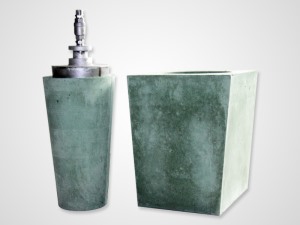4 main reasons for the damage of ladle breathable bricks
In the process of using ladle breathable bricks by iron and steel manufacturers, the main reasons for the damage of breathable bricks are thermal stress, mechanical stress, mechanical wear, and chemical erosion.
The breathable brick consists of a breathable core and a breathable seat brick. When the bottom blowing gas is turned on, the working surface of the breathable core will be in direct contact with the high-temperature molten steel. With the increase of the number of times of use, due to the rapid cooling and rapid heating, the erosion of the breathable brick core is also deeper, and cracks are easy to occur.
The working surface of the bottom-clad breathable brick is in direct contact with the high-temperature molten steel, and the temperature of the non-working face is relatively low. During the cycle of steel connection, pouring, and hot repair of the ladle, the volume of the breathable brick and nearby refractory materials changes due to temperature changes. The volume change, due to the existence of temperature gradient and the different thermal expansion coefficients between the metamorphic layer and the original layer, the degree of volume change in the process from the working face of the permeable brick to the non-working face is gradual, which will cause shearing of the permeable brick. The shear force causes cracks to appear in the horizontal direction of the breathable brick, and in severe cases, the breathable brick will break horizontally.
During the tapping process, the molten steel will have high-strength scouring on the bottom of the ladle, which will speed up the erosion of the permeable brick. The part of the brick is generally washed away after one use. In addition, after the refining is completed, if the valve is quickly closed, the reverse impact of the molten steel will also accelerate the corrosion of the breathable brick.
The working surface of the breathable brick core is in contact with steel slag and molten steel for a long time. The steel slag and molten steel contain iron oxide, ferrous oxide, manganese oxide, magnesium oxide, silicon oxide, etc., while the components of the breathable brick are alumina, silicon oxide, etc. , it will react to form low melts (such as FeO·Al2O3, 2(MnO)·SiO2·Al2O3, etc.) and be washed away.

Related News
- Introduction of construction method of ramming material in intermediate frequency furnace
- How to choose the material of furnace lining
- The difference between rammer and castable
- Application direction of intermediate frequency furnace refining
- Introduction to the construction method of dry ramming material
- Do you know the production process and control points of breathable bricks?
- The application of argon blowing technology at the bottom of the intermediate frequency furnace
- Method for prolonging service life of intermediate frequency furnace lining
- In addition to diffused breathable bricks, there are those types of breathable bricks
- What are the advantages of coil cement
- Analysis of Characteristics of Refined Ladle Dispersion Type Breathable Bricks
- Specific analysis of the ventilation performance of the ventilation brick
- Factors Affecting the Effect of Argon Blowing Bricks at the Bottom of Ladle
- Composition and properties of ramming materials for glass kilns
- Phenomenon analysis of failure of argon blowing of ladle permeable bricks and how to improve the rate of argon blowing
- How to Reduce Inclusions in Steel in Medium Frequency Induction Furnace Smelting
- What are the control points of nickel and cobalt elements in the smelting of medium frequency induction furnace?
- What are the requirements for the production materials of breathable bricks?
- How is the neutral ramming material of the intermediate frequency furnace made?
- Intermediate frequency charge manufacturer: design characteristics of coil cement


